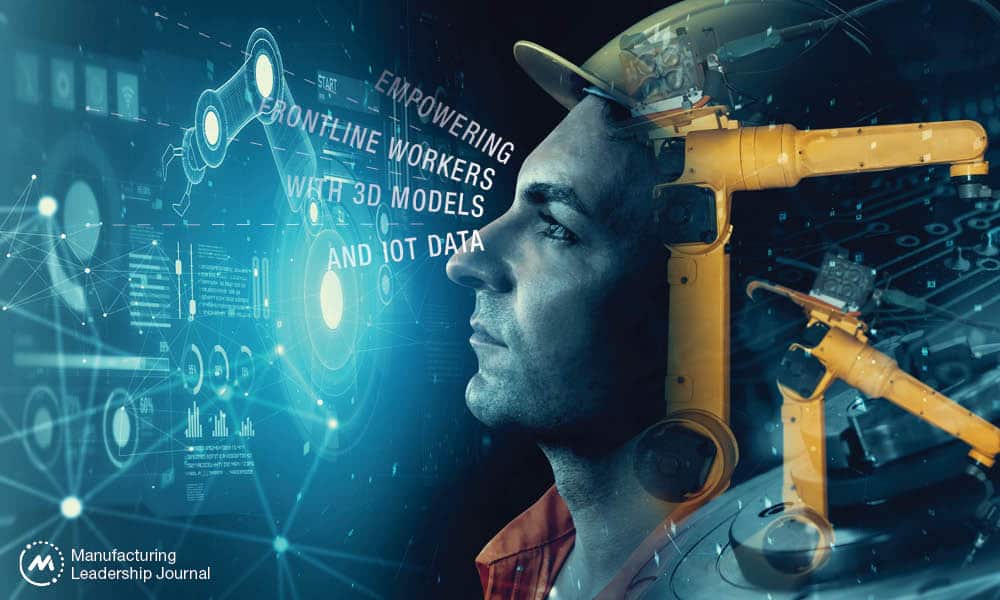Empowering Frontline Workers with 3D Models and IoT Data

Advanced technology and data are helping manufacturers’ frontline workers become more productive.

TAKEAWAYS:
● The connected worker solution integrates MBD/E with IoT and AR to provide workers with real-time information, guidance, and feedback.
● Improved agility, compliance, and quality, increased efficiency, and empowered employees are just some benefits of the connected worker solution.
● Adopting a connected worker solution in manufacturing requires a strategic and flexible approach.
“Connected Frontline Workforce (CFW) applications are a strategic differentiator to successfully address daunting challenges in safety, sustainability, productivity, quality, and overall margin goals,” said Allison Kuhn, EHS/Sustainability, Future of Industrial Work Research Analyst, of LNS Research. “CFW applications are proven human-centric platforms that accelerate business value with real-time insights and knowledge management, leading to faster, better decisions.”
Discrete manufacturers face significant challenges, including global competition, rising customer expectations, increasing product complexity, and workforce shortage—all while needing to simultaneously capture significant improvements in productivity. These challenges necessitate a transformation towards agile, efficient, and resilient operations. Despite the automation of many dull, dirty, and dangerous tasks, frontline workers remain the vital component in this transformation. However, they are expected to perform today’s tasks at tomorrow’s speed with yesterday’s resources. A Forrester study1 found that 77 percent of frontline workers don’t have access to the technology they need to be productive. Strategic technological support is therefore crucial for actionable insights, enhanced human-machine interactions, effective collaborations across value chain, as well as for fostering improved decision-making and operational efficiency.
A model-based connected worker solution (hereafter called the “connected worker”) is a key technological enabler; it integrates model-based definitions and enterprise (MBD/E) with Internet-of-Things (IoT), augmented reality (AR), analytics, and artificial intelligence (AI). MBD/E, as a key facet of industrial digital transformation, uses 3D models as the authoritative source throughout the product lifecycle. The 3D model contains vital details like geometry, tolerance, manufacturing notes, as well as associated derivatives like manufacturing bill of materials, routing, work instructions, computer numerical control (CNC)/coordinate measuring machine (CMM) programs, control plan/characteristics, etc. With 62 percent of large manufacturers adopting or considering MBD/E strategies, and 57 percent of executives prioritizing them, according to Tech-Clarity2, the connected worker solution is timely and a booster to connected frontline worker initiative.

“The reality is that frontline workers are often expected to perform today’s tasks at tomorrow’s speed with yesterday’s resources.”
The strength of the connected worker lies in how 3D models amplify the impact of IoT, AR, analytics, and AI technologies, which have already been adopted or are being adopted by industry leaders to empower frontline workers. With the increasing adoption of MBD/E, these 3D models serve as a powerful booster by further enhancing the capabilities of frontline workers. The unique value that 3D models bring to connected workers includes
- Intuitive and immersive experience: Aligning with human visual and cognitive capabilities, 3D models combined with IoT and AR make it easier to understand complex real-time data, which speeds up decision-making and response times.
- One authoritative and always synchronized product and process data: As part of MBD/E, these models ensure that factory frontline workers/machines, and their upstream/downstream co-workers/systems, respectively, access consistent, updated information across the value chain.
The integration of 3D models with IoT, AR, analytics, and AI equips frontline workers with timely insights and ensures they are prepared to face the challenges of modern manufacturing, thereby enhancing productivity and competitiveness.
Benefits of the Connected Worker
The connected worker solution can help manufacturers achieve several benefits:
- Speed and agility: By providing workers with model-based work instructions, the solution can reduce the time and errors involved in manual and paper-based processes and enable faster and more flexible responses to changes and customer demands.
- Efficiency and cost: By connecting workers with model-based connected machines, the solution can optimize the use and performance of assets, and reduce downtime, waste, and maintenance costs.
- Quality and compliance: By enabling workers to perform end-of-line inspections and use data to solve problems, the solution can improve the quality and consistency of products and ensure compliance with standards and regulations.
- Frontline worker empowerment and engagement: Frontline workers benefit from on-the-job learn & do with intuitive work instructions in a 3D context, improved knowledge capture and sharing, and the elimination of non-value-added activities.
Connected Worker Use Cases and Case Studies
We present four examples of connected worker use cases that demonstrate how manufacturers can start with minimal investment yet reap significant benefits. These examples showcase practical and efficient applications of the connected worker concept in real-world scenarios.
1. Model-based Work Instructions and Execution
A case study of Vestas shows how a model-based connected worker solution can help workers assemble complex components with higher accuracy and efficiency, improving first-time build rate and better-quality outcomes.
Problem: Vestas had a dynamic build process, and detailed work instructions that were traditionally printed on hundreds of thousands of paper pages and sent out to more than 23,000 employees. Also, given the size and complexity of wind turbines, particularly with the recent uptick in global demand, Vestas employees required more in-context information to meet these challenges.
Solution: Vestas introduced PTC’s Manufacturing Solutions, which equipped machine operators with the relevant information needed to identify and complete tasks in the right sequence with the right tools—including role-specific digital work order information and instructions with rich CAD drawings and videos —all in a single interface. This solution will help ease the impact felt by the veteran employees retiring and combat the current volatility around employee retention.
2. Model-based Connected Machine
A large construction equipment manufacturer is exploring a model-based manufacturing strategy to avoid human errors and improve product and process quality by automating human-machine interaction with programmatic information extracted directly from the 3D model.
Problem: The manufacturer has many different types of machines, including welding, CNC, and CMM. There is a lot of manual work involved in copying and pasting engineering documents, process planning documents, control plans, and CNC/CMM programs between engineering and manufacturing operations. This results in significant delays in production preparation time and more errors in human transcription.
Solution: The manufacturer is implementing a model-based manufacturing strategy that starts with engineering by creating a single 3D product model that is leveraged by up to 100 downstream deliverables, including control characteristics details that flow automatically into welding, CNC, and CMM machines and which collects processing and testing results for further variation analysis.

“AR solutions help frontline workers view clear, detailed digital content in the context of their physical environment.”
3. End-of-line Inspection
A case study of Magna, an automotive supplier, shows how the solution can help workers inspect and verify the quality of products using AR and IoT devices, reducing defects and recalls.
Problem: There is very little room for error in the fast-paced automotive industry, and as vehicles become more complex, so does the assembly process. Many sequential steps need to happen within a given time frame. With manual processes and 2D paper-based instructions, training an operator on these steps is time consuming and challenging. Magna also had found that improperly fitted electrical plugs were passing continuity testing but then coming undone with movement—they required an extra layer of inspection for this part moving forward.
Solution: AR quality verification solutions help frontline workers view clear, detailed digital content in the context of their physical environment. PTC’s AR solution made it easy to create AR-guided tasks, checklists, and data capture. Magna used the AR solution to address its training outcomes, as trained workers can create first-person points of view of parts being assembled for trainees to follow. Training can also be enhanced with locational awareness, videos, images, and diagrams to provide extra content for new employees. Magna also used AR to enable operator inspection, intuitively creating quality inspection procedures that were more efficient and which reduced scrap, rework, and defects.
4. Closed-loop Problem-solving
A case study of Northrop Grumman, an aerospace manufacturer, shows how the connected worker solution can help workers analyze and visualize data from the factory floor, and identify and resolve issues that affect the quality and productivity.
Problem: Management challenged a business unit within Northrop Grumman to double its revenue in the next seven years. Struggling to unlock new capacity in its facility (even while running 24/7 operations) and to pull actionable data from relevant machinery, the director of Continuous Improvement conducted a Proof of Value and found that some of the company’s most important machinery was operating at a subpar OEE (Overall Equipment Efficiency) of 45 percent.
Solution: The Continuous Improvement solution has automated the lengthy and costly process of collecting data, and an initial analysis showed that the assets in question had the operational availability of 90–100 percent. These analytics empower frontline workers with the data they need to make informed decisions and to do targeted troubleshooting. Weekly reports empower the director to make decisions that have executive and operator buy-in. Waterfall analyses also unearthed an unexpected 50 hours of monthly re-work in a machine that wasn’t originally identified as a bottleneck. The implementation on the first line reduced cycle time and increased throughput that resulted in $2.5M additional potential revenue annually.

“This [a connected worker solution] involves empowering frontline workers with advanced technologies while ensuring the solution aligns with the company’s specific needs and readiness.”
Where to Start
To successfully implement a connected worker solution in manufacturing, it’s crucial to adopt a strategic and flexible approach. This involves empowering frontline workers with advanced technologies while ensuring the solution aligns with the company’s specific needs and readiness. Here’s how manufacturers can navigate this transformative journey:
- Use the agile composable approach: Prioritize a composable business architecture using modular building blocks. This approach allows for flexibility, scalability, and integration with existing systems, leading to cost-effective and agile solutions.
- Prioritize technology deployment with improvement to financial P&L: Identify top manufacturing bottlenecks and apply connected worker technology to eliminate and prioritize the most pressing issues. Identify the right solutions that will have the biggest impact on operational performance and drive fast time to value.
- Empower frontline workers with actionable insights: Assess and equip workers with advanced digital tools and access to critical insights when and where there is most impact. Doing so enhances efficiency, safety, and satisfaction, boosting productivity and quality.
- Implement MBD and integrate Product Lifecycle Management (PLM): Use fully defined 3D models as the authoritative source of the product and process data across the product lifecycle. Establish a strong PLM foundation to manage complex and detailed product data effectively. This ensures workers have access to accurate, up-to-date technical data facilitating informed decisions.
- Ensure closed-loop integration across the lifecycle: Connect engineering, manufacturing engineering, and shop-floor processes. Use IoT for real-time monitoring and feedback, and promote continuous improvement in product development and optimization.
- Frontline workers have yet to benefit directly from many of the promises of industrial digital transformation. This article strives to outline some of the most relevant tools leveraging data to empower frontline workers today, as well as to provide an introductory guide for those who are early on their adoption lifecycle. M
References
1. Williams, E. New research highlights massive opportunity to empower Firstline Workers with technology. Microsoft, December 14, 2018.
2. Boucher, M. Adopting a Model-Based Enterprise Strategy. Tech-Clarity, July 2, 2022.
About the authors:

Gonzalo Chavez is a senior analyst in Market Development, Connected Operations Solutions at PTC.

Howard Heppelmann is divisional vice president and general manager of PTC’s ThingWorx IoT Solutions.

Dirk Schart is senior director Go-to-Market at PTC and leads the global Vuforia marketing.

James Zhang is vice president of Market Development, IoT at PTC.
- Need more information: Contact the team at PTC